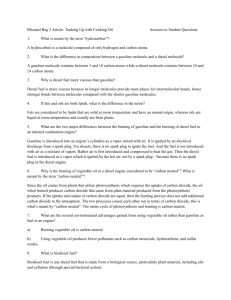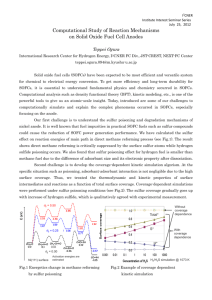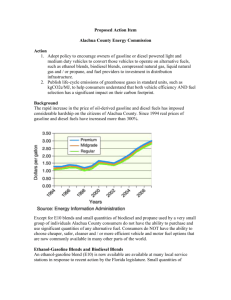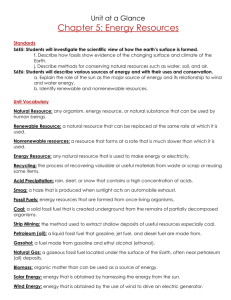M-Walsh-Sulfur-Fuels
advertisement
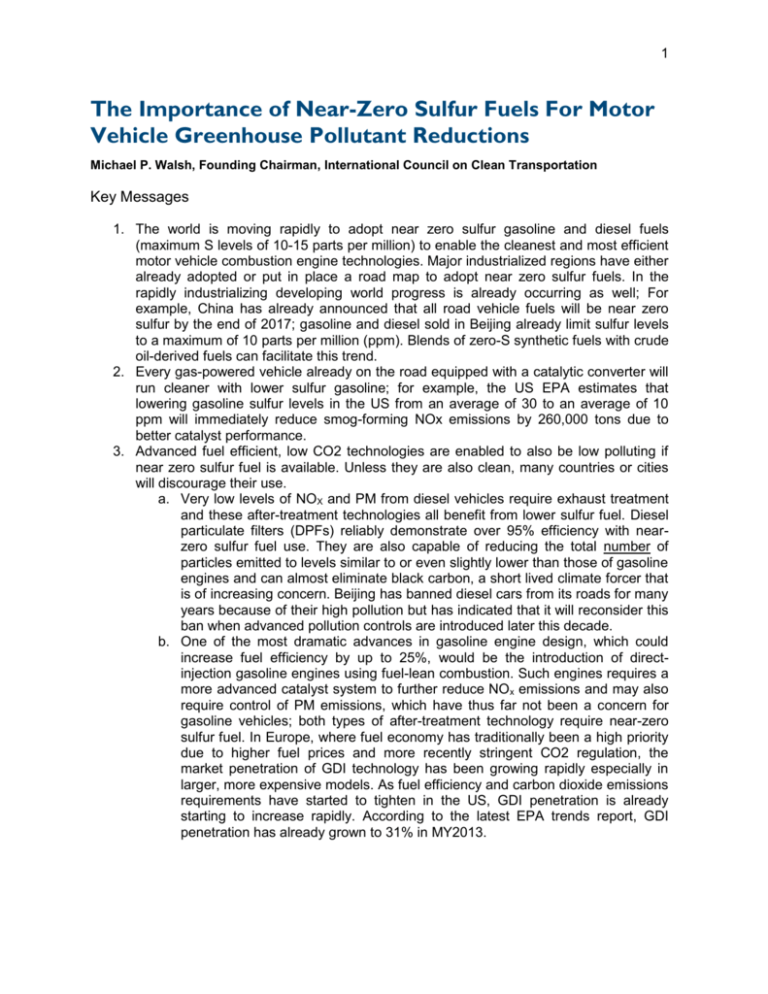
1 The Importance of Near-Zero Sulfur Fuels For Motor Vehicle Greenhouse Pollutant Reductions Michael P. Walsh, Founding Chairman, International Council on Clean Transportation Key Messages 1. The world is moving rapidly to adopt near zero sulfur gasoline and diesel fuels (maximum S levels of 10-15 parts per million) to enable the cleanest and most efficient motor vehicle combustion engine technologies. Major industrialized regions have either already adopted or put in place a road map to adopt near zero sulfur fuels. In the rapidly industrializing developing world progress is already occurring as well; For example, China has already announced that all road vehicle fuels will be near zero sulfur by the end of 2017; gasoline and diesel sold in Beijing already limit sulfur levels to a maximum of 10 parts per million (ppm). Blends of zero-S synthetic fuels with crude oil-derived fuels can facilitate this trend. 2. Every gas-powered vehicle already on the road equipped with a catalytic converter will run cleaner with lower sulfur gasoline; for example, the US EPA estimates that lowering gasoline sulfur levels in the US from an average of 30 to an average of 10 ppm will immediately reduce smog-forming NOx emissions by 260,000 tons due to better catalyst performance. 3. Advanced fuel efficient, low CO2 technologies are enabled to also be low polluting if near zero sulfur fuel is available. Unless they are also clean, many countries or cities will discourage their use. a. Very low levels of NOX and PM from diesel vehicles require exhaust treatment and these after-treatment technologies all benefit from lower sulfur fuel. Diesel particulate filters (DPFs) reliably demonstrate over 95% efficiency with nearzero sulfur fuel use. They are also capable of reducing the total number of particles emitted to levels similar to or even slightly lower than those of gasoline engines and can almost eliminate black carbon, a short lived climate forcer that is of increasing concern. Beijing has banned diesel cars from its roads for many years because of their high pollution but has indicated that it will reconsider this ban when advanced pollution controls are introduced later this decade. b. One of the most dramatic advances in gasoline engine design, which could increase fuel efficiency by up to 25%, would be the introduction of directinjection gasoline engines using fuel-lean combustion. Such engines requires a more advanced catalyst system to further reduce NOx emissions and may also require control of PM emissions, which have thus far not been a concern for gasoline vehicles; both types of after-treatment technology require near-zero sulfur fuel. In Europe, where fuel economy has traditionally been a high priority due to higher fuel prices and more recently stringent CO2 regulation, the market penetration of GDI technology has been growing rapidly especially in larger, more expensive models. As fuel efficiency and carbon dioxide emissions requirements have started to tighten in the US, GDI penetration is already starting to increase rapidly. According to the latest EPA trends report, GDI penetration has already grown to 31% in MY2013. 2 Background Gasoline and diesel fuels are produced from crude oil, which varies from oilfield to oilfield in color and composition. Sulfur is a naturally occurring substance in crude oil and the amount can range anywhere from 100 to 33,000 parts per million (ppm)1. When crude oil is processed into gasoline and diesel fuel in the refinery, some sulfur remains. Depending on the crude oil used and the refinery configuration, sulfur levels in gasoline can be anywhere from 10 to as high as 1000 ppm or more, and in diesel fuel it can be from 15 or lower to more than 10,000 ppm. In industrialized countries today average S contents of transportation fuels range from 30 ppm to less than 10 ppm. In March 2014 the US EPA adopted a new rule requiring that by 2017 gasoline sold in the US must contain no more than 10 ppm S on average (a similar level has already been realized in California, Europe, Japan, South Korea, and several other countries)—down from the present 30 ppm. Diesel fuel sulfur levels in the US were already reduced to a maximum of 15 ppm in 2006 and similar or even lower limits are also in place in most industrialized countries. Although S levels are typically much higher in developing countries, the global trend is toward fuels with near-zero (< 10 ppm) S. For example, China’s State Council announced in February of 2013 that new transportation fuel quality standards will require that by the end of 2017 the maximum sulfur contents of both gasoline and diesel fuels sold in China must have no more than 10 ppm S. Gasoline and diesel sold in Beijing already limits sulfur levels to a maximum of 10 ppm. Blends of zero-S synthetic fuels with crude oil-derived fuels can facilitate this trend. Transportation fuels with near-zero S offer benefits of: (a) enabling the more efficient use of existing pollutant control equipment, (b) facilitating the commercial introduction of advanced pollution control equipment, and (c) facilitating the commercial introduction of more fuelefficient motor vehicle technologies. Gasoline Fueled Vehicles The pollutants of greatest concern from gasoline-fuelled vehicles are CO, HC, NOX, and certain toxic hydrocarbons such as benzene, formaldehyde, acetaldehyde, and 1,3-butadiene. Sophisticated technologies have evolved over the past several decades to reduce these harmful pollutants. Modern gasoline engines use computer controlled intake port fuel injection with feedback control based on an oxygen sensor to meter precisely the quantity and timing of fuel delivered to the engine. Control of in-cylinder mixing and use of high-energy ignition promote nearly complete combustion. But the three-way catalyst which is added to almost every new gasoline car produced in the world today is critical for cleaning up all that remains and typically provides greater than 90% reduction of carbon monoxide, hydrocarbons, and oxides of nitrogen. Designs for rapid warm-up minimize cold-start emissions. On-board diagnostic (OBD) systems sense emissions systems performance and identify component failures. Durability in excess of 160,000 km, with minimal maintenance, is now common. Three way catalytic converters were introduced on cars in the United States and Japan well before the impact of sulfur on catalyst performance was fully understood. We now know that sulfur in gasoline reduces the efficiency of catalysts and adversely affects heated exhaust gas oxygen sensors. High sulfur gasoline is a barrier to the introduction of new lean burn 1 Part Per Million - is normally used as measure for the sulfur content in fuels. It can be roughly translated in percentages: 10,000 ppm would mean the fuel would contain 1% sulfur. 3 technologies using De-NOX catalysts, while low sulfur gasoline will enable new and future conventional vehicle technologies to realize their full benefits. If sulfur levels are lowered, existing vehicles equipped with catalysts will generally have improved emissions. Laboratory testing of catalysts has demonstrated reductions in efficiency resulting from higher sulfur levels across a full range of air/fuel ratios. The effect is greater in percentage for lowemission vehicles than for traditional vehicles. Studies have also shown that sulfur adversely affects heated exhaust gas oxygen sensors; slows the lean-to-rich transition, thereby introducing an unintended rich bias into the emission calibration; and may affect the durability of advanced on-board diagnostic (OBD) systems. The EPA mandate for reducing the S content of gasoline to near-zero was motivated in part because the reduced S content will facilitate realization of EPA’s proposed new regulations to reduce emissions of non-methane organic gases (NMOG) and NOx during 2017-2025 for gasoline cars, by enabling pollution control technologies to operate more efficiently. Even cars built prior to implementation of the proposed NMOG and NOx standards will run cleaner using the proposed low-S gasoline, providing significant and immediate health benefits. EPA estimates that because every gas-powered vehicle already on the road equipped with a catalytic converter will run cleaner with the lower sulfur gasoline, smog-forming NOx emissions will be reduced by 260,000 tons in 2018 in the United States. The percentage benefits of reducing sulfur levels in fuels increase as vehicles are designed to meet stricter standards. Increasingly strict emissions standards require extremely efficient catalysts over a long lifetime. Recent regulations in Europe and the U.S. require warmed-up catalysts to have over 98% HC control, even towards the end of the vehicle’s lifetime (100,000 km in Europe and over 100,000 miles in the U.S.). Another compelling motivation for the proposed gasoline mandate is that it would facilitate a shift to more fuel-efficient cars. The Obama Administration is pursuing a regulatory approach to climate-change mitigation, under which the EPA has established standards that require declining average CO2 emission rates for new cars. The industry average is to reach 163 grams per mile (101 grams per km) of carbon dioxide (CO2) by 2025—equivalent to a fuel economy of 54.5 miles per gallon (mpg) of gasoline (4.32 liters/100 km) if the mandate were achieved solely via energy efficiency improvements. For comparison, the average new car US fuel economy in 2010 was 25.5 mpg (9.23 liters/100 km). One of the most dramatic advances in gasoline engine design, which could increase fuel efficiency by up to 25%, would be the introduction of direct-injection gasoline engines using fuel-lean combustion. Such engines requires a more advanced catalyst system to further reduce NOx emissions and may also require control of PM emissions, which have thus far not been a concern for gasoline vehicles; both types of after-treatment technology require nearzero sulfur fuel.2 In Europe, where fuel economy has traditionally been a high priority due to higher fuel prices and more recently stringent CO2 regulation, the market penetration of GDI technology has been growing rapidly especially in larger, more expensive models as illustrated below. As fuel efficiency and carbon dioxide emissions requirements have started to tighten in 2 Blumberg et al. (2003). 4 the US, GDI penetration is already starting to increase rapidly. According to the latest EPA trends report, GDI penetration has already grown to 31% in MY2013.3 Gasoline Direct Injection Market Penetration in Europe – Selected Manufacturers Diesels emit high levels of oxides of nitrogen and particulates. Modest to significant NOX control can be achieved by delaying fuel injection timing and adding exhaust gas recirculation (EGR). Very high pressure, computer controlled fuel injection can also be timed to reduce PM emissions. Modifying engine parameters to simultaneously reduce both NOX and PM is difficult and limited since the optimal settings for one pollutant frequently increases emissions of the other and vice-versa. Very low levels of NOX and PM therefore require exhaust treatment and these after-treatment technologies all benefit from lower sulfur fuel. Lean NO X catalysts, selective catalytic reduction, NOX storage traps with periodic reduction, filter traps with periodic burn-off, and oxidation catalysts with continuous burn-off are evolving technologies that are being phased in at differing rates in various parts of the world. Diesel particulate filters (DPFs) reliably demonstrate over 95% efficiency with near-zero sulfur fuel use. They are also capable of reducing the total number of particles emitted to levels similar to or even slightly lower than those of gasoline engines. Filters however need to be cleaned, ideally without human intervention, before reaching capacity in order to maintain vehicle performance and fuel and filter efficiency. The Continuously Regenerating Diesel Particulate Filter (CR-DPF) and the Catalyzed Diesel Particulate Filter (CDPF) are two examples of PM control with passive regeneration. The CRDPF and CDPF devices were found to achieve 95% efficiency for control of PM emissions with 3 ppm sulfur fuel.4 Efficiency dropped to zero with 150 ppm sulfur fuel and PM emissions more “Light Duty Automotive Technology, Carbon Dioxide Emissions and Fuel Economy Trends: 1975 through 2013”, US EPA, December 2013 3 4US Department of Energy 1999, Diesel Emission Control—Sulfur Effects (DECSE) Program US Department of Energy: Washington, DC. Available URL: http://www.ott.doe.gov/decse/ 5 than doubled over the baseline with 350 ppm sulfur fuel. With 50 PPM sulfur, advanced PM filters can work satisfactorily – more than 75% reduction of PM2.5 and smaller particles although not as well as with 10 PPM sulfur. The systems recover to original PM control efficiency, over 95% with a shift to use of near-zero sulfur fuels, but recovery takes time due to sulfate storage on the catalyst. Sulfur also increases the required temperature for regeneration of the filter. In moving from 3 to 30 ppm sulfur fuel, the exhaust temperatures required for regeneration increase by roughly 25°C. Blends of near-zero sulfur synthetic diesel with crude oil-derived diesel would also facilitate greater use of diesel cars in quests to reduce CO2 emissions. Because of their higher fuel economy, current diesel engines can reduce CO2 emissions by 30% compared to conventional gasoline cars although this gap is narrowing. With advanced engine designs such as turbo direct-injection, diesels could achieve up to a 45% reduction in CO2 emissions. However, some areas prohibit or discourage the use of diesel cars, thus foregoing their fuel efficiency and CO2 advantages, because of their higher NOx and PM emissions than gasoline cars; Beijing is a good example. To meet new emissions standards for conventional pollutants in the U.S. and Europe, both current and advanced diesel engines require advanced exhaust aftertreatment technologies—the introduction of which would be greatly facilitated by availability of near-zero S diesel fuel. Black Carbon A product of inefficient combustion, black carbon, also known as soot, consists of microscopic solid particles of incompletely burned organic matter. Black carbon is a potent warmer, exerting effects on the global climate both while suspended in the atmosphere and when deposited on snow and ice. In fact, one study estimates that a given mass of black carbon will warm the air between 360,000 and 840,000 times more than an equal mass of carbon dioxide.5 While the quantification is quite variable, a large number of recent studies have raised serious concerns regarding the climate impacts of black carbon. 6 The most pernicious characteristic of black carbon from a climatic perspective is its dark color and correspondingly low albedo, or reflectivity. Because of this dark coloring, black carbon absorbs heat from sunlight. A very recent study finds that soot is warming the climate about twice as fast as scientists had estimated.7 The new, deeper view puts soot second behind the dominant agent forcing 5 Mark Z. Jacobson, Control of Fossil-Fuel Particulate Black Carbon and Organic Matter, Possibly the Most Effective Method of Slowing Global Warming, 107 Journal Of Geophysical Research 4410 (2002) at 10. 6 Delucchi MA. 2003. Appendix D: CO2 Equivalency Factors. . An Appendix to the Report, "A Lifecycle Emissions Model (LEM): Lifecycle Emissions from Transportation Fuels, Motor Vehicles, Transportation Modes, Electricity Use, Heating and Cooking Fuels, and Materials. Davis, California: Institute of Transportation Studies, Contribution of Working Group I to the Fourth Assessment Report of the Intergovernmental Panel on Climate Change. Cambridge, UK and New York, USA, Fuglestvedt JS, Berntsen TK, Godal O, Sausen R, Shine KP, Skodvin T. 2003. Metrics of Climate Change: Assessing Radiative Forcing and Emission Indices. Climatic Change 58(3):267331, Hansen J, Sato M, Ruedy R, Lacis A, Oinas V. 2000. Global Warming in the 21st Century: An alternative Scenario. Proceedings of the National Academy of Sciences 97(18):9875-9880, Ramanathan V. 2007. Role of Black Carbon on Global and Regional Climate Change. House Committee on Oversight and Government Reform, 110th Congress, 1st Session. Washington, DC. 7 “Bounding the role of black carbon in the climate system: A scientific assessment” T. C. Bond, S. J. Doherty, D. W. Fahey, P. M. Forster, T. Berntsen, B. J. DeAngelo, M. G. Flanner, S. Ghan, B. Kärcher, D. Koch, S. Kinne, Y. Kondo, P. K. Quinn, M. C. Sarofim, M. G. Schultz, M. Schulz, C. Venkataraman, H. Zhang, S. Zhang, N. Bellouin, 6 warming, carbon dioxide, which accounts for 1.66 W/m2. Soot's contribution to the warming is roughly twice as large as estimated in the 2007 assessment made by the Intergovernmental Panel on Climate Change. Introducing advanced particulate control technologies such as diesel particulate filters are also very effective at reducing black carbon emission, an important added co-benefit. Concluding Remarks on Vehicles and Fuels One of the most important lessons learned in the approximately 50 year history of vehicle pollution control worldwide is that vehicles and fuels must be treated as a system. Improvements in vehicles and fuels must proceed in parallel if significant improvements in vehicle related air pollution are to occur. A program that focuses on vehicles alone is doomed to failure; conversely, a program designed to improve fuel quality alone also will not be successful. In following this systems approach, the most important fuel parameter is sulfur. Once near zero sulfur fuels are mandated, the path to state of the art vehicle pollution control and efficiency technologies is greatly simplified. S. K. Guttikunda, P. K. Hopke, M. Z. Jacobson, J. W. Kaiser, Z. Klimont, U. Lohmann, J. P. Schwarz, D. Shindell, T.Storelvmo, S. G. Warren, C. S. Zender, DOI: 10.1002/jgrd.50171


